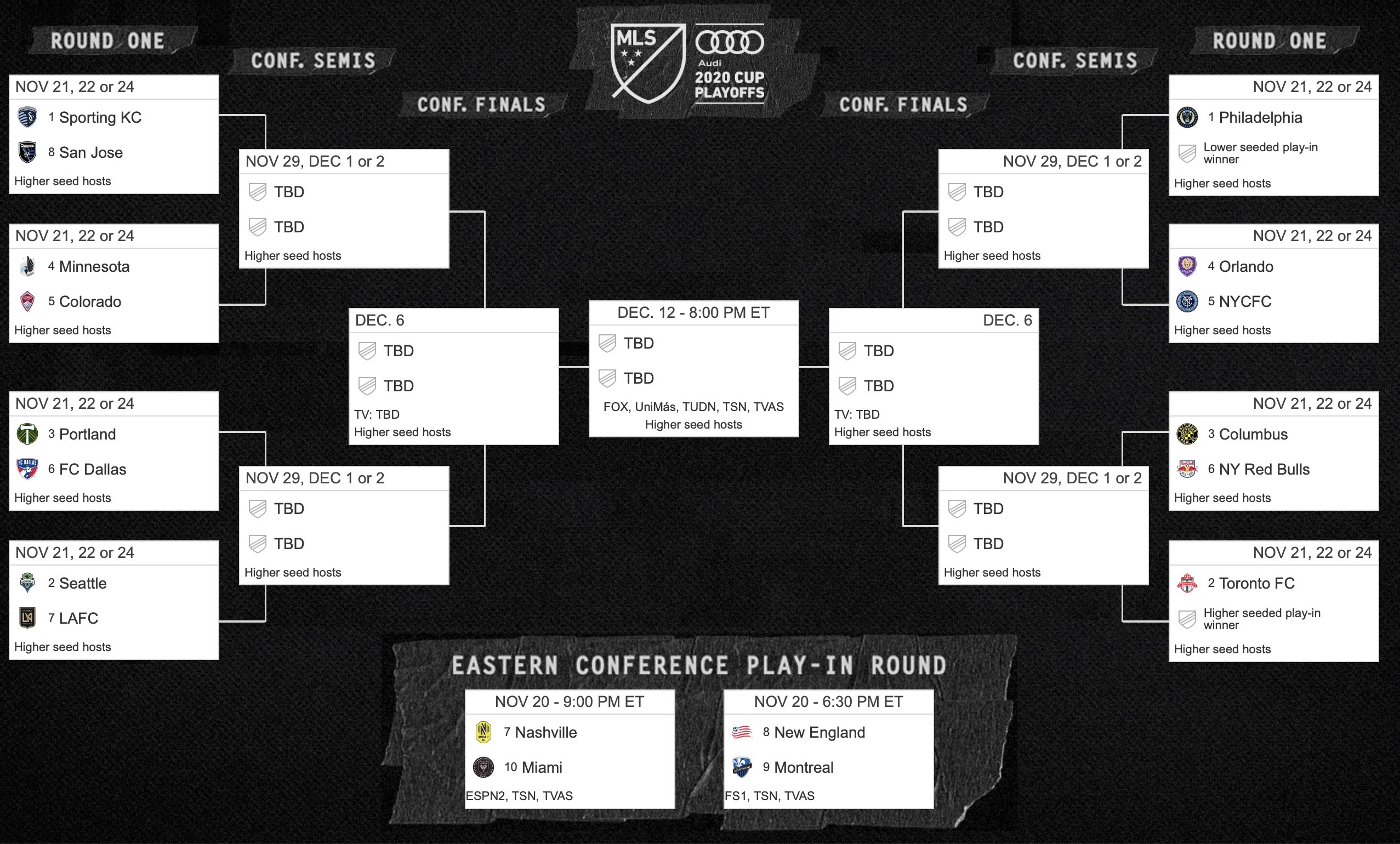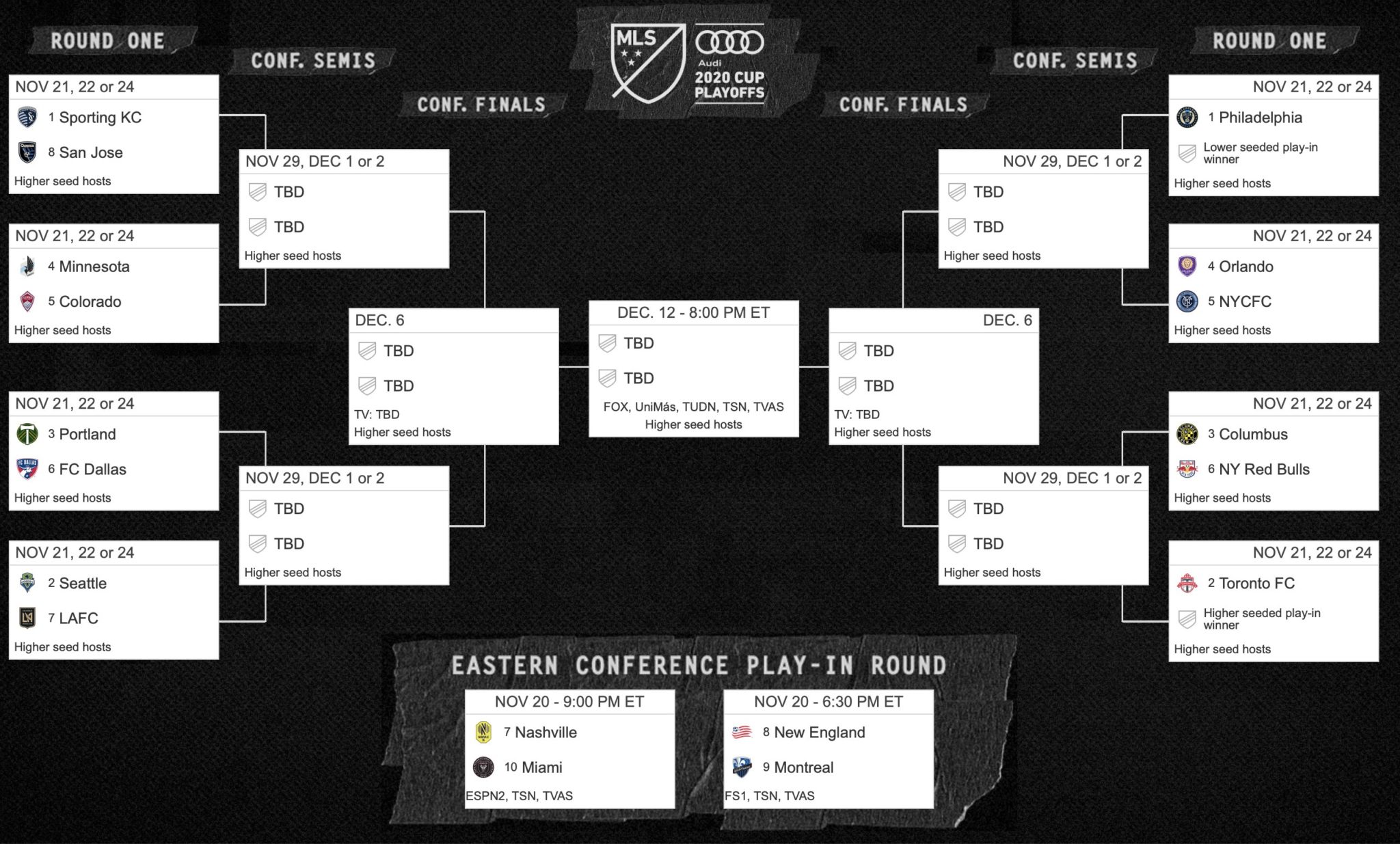Ever wondered how MLS teams navigate the treacherous waters of the playoffs? The answer lies in the playoff bracket, a meticulously designed system that dictates the fate of every contender, from the first whistle of the postseason to the final, triumphant roar. Understanding its intricacies is not just about appreciating the competition; it's about unlocking the secrets to victory.
The structure of the Major League Soccer (MLS) postseason, graphically depicted as a bracket, outlines the progression of teams vying for the league championship. Teams are meticulously seeded based on their regular season performance, a process that often grants higher seeds favorable matchups in the early rounds. This format isn't just a formality; it's designed to ensure a grueling, challenging path for all contenders, with the ultimate champion emerging only after a series of intense, high-stakes knockout matches played across multiple legs. The road to glory in the MLS is paved with strategic brilliance, unwavering determination, and a healthy dose of luck within the framework of this bracket.
The MLS playoff bracket system is nothing short of crucial when it comes to crowning the champion. It establishes a structured elimination process, a meritocracy of sorts, rewarding teams that demonstrated consistent excellence during the regular season with higher seeds and, consequently, forcing them to prove their worth against equally formidable opponents. This carefully structured process, fraught with inherent challenges and tactical complexities, is the lifeblood of excitement and competition within the league. It culminates in a championship game that is not just a match, but a spectacle that defines the season. The playoff bracket, in essence, crafts the very narrative of the season, shedding light on the strengths, weaknesses, and resilience of different teams and players throughout the competition. It's a story told in wins and losses, in strategic masterclasses and heartbreaking defeats.
- Joss Whedon Exploring The Cultural Impact And Creative Legacy
- Breaking Is Iu Getting Married The Truth Amp Fan Reaction Now
Transitioning to a more detailed examination of the bracket system, this analysis will delve into the multifaceted aspects of the tournament, including the intricate seeding methodology, the relentless knockout rounds, and the overall format that governs this annual battle for supremacy. It's a deep dive into the strategic heart of MLS.
The Major League Soccer playoff bracket dictates the path to the championship. Understanding its structure is essential for grasping the season's intensity and competition.
- Seedings
- Knockout rounds
- Home-field advantage
- Elimination format
- Conference structures
- Playoff schedule
- Championship match
- Match outcomes
Seedings set the stage for initial matchups, often favoring higher seeds with coveted home-field advantage in the early rounds. Knockout rounds are pressure cookers, where every decision carries immense weight. The unforgiving elimination format ensures a level of relentless competition rarely seen elsewhere. Conference structures subtly but significantly influence the seeding process, adding another layer of strategic depth. The playoff schedule, meticulously crafted, builds suspense with each passing game. The championship match is the crescendo, the moment when the league champion is crowned. Finally, match outcomes send ripples throughout the playoff narrative and dictate future season trajectories. Comprehending these intricate aspects allows fans and analysts alike to truly appreciate the complex system that fuels the MLS postseason. It's a chess match played on a grand scale.
- George Clooney Children Truth Rumors And What We Know
- Christopher Brosnan A Complete Guide About This Actors Life
1. Seedings
Seedings in the MLS playoff bracket are not merely administrative details; they are the bedrock upon which the entire tournament is built. A team's performance throughout the grueling regular season directly and decisively influences its placement within the bracket. Higher seeds, the reward for consistent excellence, generally receive advantageous matchups in the opening rounds. This system, deliberately designed to reward sustained success during the regular season, establishes the fundamental framework for the playoff tournament. A team that has proven its mettle over months of competition, securing a strong regular season record and, consequently, a higher seed, is often afforded a more favorable pathway toward the ultimate prize the championship. This translates to potentially facing fewer daunting opponents in the early rounds, which in turn allows for greater consistency in performance and an increased likelihood of progressing deeper into the tournament's labyrinthine structure.
Seedings are the architects of the playoff landscape, significantly impacting potential match-ups and shaping the tournament's overall narrative. Teams that have earned their place among the higher echelons of the seeding often find themselves with more favorable initial matchups, encountering less experienced or lower-ranked opponents early on. This smoother initial progression through the bracket can be the difference between building momentum and facing an uphill battle from the outset. Conversely, lower seeds are thrust into the crucible of stronger competition in the opening rounds, demanding a level of resilience and tactical brilliance to advance against the odds. This variance in initial opposition is not arbitrary; it directly reflects the variations in teams' strengths and the hard-earned results of their respective regular seasons. For example, a team seeded exceptionally high, a testament to their dominance throughout the year, might find itself facing a lower-seeded opponent in the first round, a team perhaps fueled by an underdog narrative and a burning desire to prove themselves. On the other hand, a lower seed might be immediately confronted with a high-seeded, highly formidable opponent in the opening round, forcing a more challenging and demanding early-round battle. The outcomes of these early match-ups have a profound effect on the subsequent stages of the playoff tournament, defining a team's journey to the championship. Each victory, each defeat, shapes the narrative and alters the landscape of the competition.
The significance of seedings in the MLS playoffs stems from their direct and undeniable correlation to a team's probable success. A strong regular season, culminating in a favorable seed, provides a tangible and significant edge in the high-stakes environment of the postseason. This structured advantage, firmly rooted in the concept of rewarding consistent performance and sustained excellence, is a critical component of the league's playoff bracket. Therefore, a thorough understanding of the seeding system is paramount to analyzing the potential outcomes and predicting the paths teams might take in their pursuit of championship glory. This understanding, in turn, enriches the overall appreciation of MLS competition, transforming the viewer from a passive observer to an informed and engaged participant. It's about understanding the rules of the game and appreciating the strategic brilliance that unfolds within those parameters.
2. Knockout Rounds
Knockout rounds, a defining and often brutal feature of the MLS playoff bracket, are the crucible in which the ultimate champion is forged. These crucial stages of the tournament demand an unwavering level of intensity, as advancement hinges solely on securing victory in each match. This unforgiving elimination-style format, a cornerstone of the postseason structure, dictates the entire journey toward the championship, leaving no room for error and demanding peak performance at every turn.
- Sequential Elimination
Each knockout round is characterized by a series of high-stakes matches where only one team from each pairing progresses to the next stage. Teams are eliminated without reprieve upon suffering a defeat, creating a progressively narrowing field of competitors. The relentless progression through these rounds intensifies the competition with each passing match, as the number of teams remaining in contention dwindles. This sequential elimination process ensures a high level of competitiveness, where each victory is not just a win, but a step closer to the ultimate prize, making each moment significantly more valuable in the relentless pursuit of the championship. The high-stakes nature of the format is mirrored in other sports around the globe, where a single defeat can spell the end of a team's championship aspirations, highlighting the universal pressure inherent in knockout competitions.
- Impact on Team Strategies
The inherent pressure of the knockout format necessitates significant and often drastic adjustments in team strategies. Teams may be forced to adopt entirely different approaches to maximize their chances of success in each round, potentially shifting their focus to specific tactical deployments or making crucial changes to their player lineups. The pressure to win intensifies exponentially as teams advance further into the bracket, profoundly impacting the teams' likelihood of progressing deeper into the tournament. An analysis of consistently successful teams often reveals strategic adaptations made specifically for the knockout rounds, a testament to their ability to adjust and thrive under pressure, compared to their tactics during the more forgiving regular season.
- Varying Matchups
The composition of match-ups in the knockout rounds is intricately determined by a combination of seeding and conference placement within the playoff bracket. Teams with higher seeds are generally rewarded with matchups against opponents with a lower seeding, potentially leading to varying levels of difficulty and requiring different strategic approaches during these crucial knockout rounds. The unpredictability of these matches is part of the charm of the competition, often resulting in surprising outcomes that defy expectations and disrupt the established order. This variability can create compelling and captivating match-ups that significantly impact the tournament's narrative and overall excitement, transforming the event into a captivating spectacle.
- Pressure and Performance Fluctuation
The immense pressure that defines the knockout rounds often leads to observable and sometimes dramatic fluctuations in team performance. Teams may experience elevated levels of anxiety and stress, which can negatively affect player performance and lead to suboptimal strategic decisions. The significance of each match increases exponentially, leading to periods of intense pressure and potential shifts in team dynamics as players and coaches grapple with the weight of expectation. Understanding how teams respond to this pressure, both individually and collectively, is crucial for accurately analyzing playoff outcomes and predicting potential upsets.
| Jurgen Klinsmann | |
|---|---|
| Personal Information | |
| Date of Birth | July 30, 1964 |
| Place of Birth | Gppingen, West Germany |
| Nationality | German, American |
| Playing Career | |
| Position | Striker |
| Senior Clubs | Stuttgarter Kickers, VfB Stuttgart, Inter Milan, AS Monaco, Tottenham Hotspur, Bayern Munich, Sampdoria, Orange County Blue Star |
| National Team | Germany (108 caps, 47 goals) |
| Managerial Career | |
| Teams Managed | Germany, Bayern Munich, United States, Hertha BSC |
| Achievements | |
| Playing | FIFA World Cup (1990), UEFA European Championship (1996), UEFA Cup (1991), Bundesliga (1994), DFB-Pokal (1996) |
| Managerial | FIFA World Cup Third Place (2006 - Germany), CONCACAF Gold Cup (2013 - United States) |
| Website | DFB Profile |
- Breaking Does Alec Bohm Have Siblings Family Life Explored
- Bill Hemmers Web Inside His Relationships Career Impact


